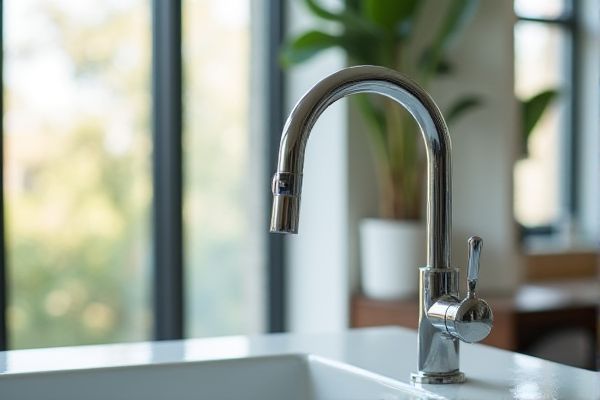
Touchless faucets offer enhanced hygiene and convenience by allowing you to activate water flow without physical contact, reducing the spread of germs and conserving water with sensor-based technology. Explore the detailed comparison of touchless versus manual faucets to discover which option best suits your lifestyle and needs.
Table of Comparison
| Feature | Touchless Faucet | Manual Faucet |
|---|---|---|
| Operation | Sensor-activated, no touch required | Manual handle or knob control |
| Hygiene | Reduces germ transfer, more sanitary | Higher risk of contamination via handles |
| Water Conservation | Automatic shut-off prevents wastage | Potential for water waste if left running |
| Installation | Requires electrical connection or batteries | Simple plumbing installation |
| Maintenance | Sensor calibration and battery replacement needed | Minimal maintenance, mostly mechanical |
| Cost | Higher initial purchase and installation cost | Lower upfront cost and simpler repairs |
| Durability | Sensitive to electrical issues, sensor damage possible | Mechanical parts easier to repair or replace |
| Suitability | Ideal for public, healthcare, and commercial use | Common in residential and standard applications |
Introduction to Touchless and Manual Faucets
Touchless faucets use motion sensors to detect hand movements, enabling water flow without physical contact, promoting hygiene and reducing water waste. Manual faucets require direct handling to control water flow and temperature, offering simplicity and reliability in various settings. Choosing between touchless and manual faucets depends on your preferences for convenience, maintenance, and overall sanitation needs.
How Touchless Faucets Work
Touchless faucets operate using infrared sensors that detect the presence of hands or objects beneath the spout, triggering the integrated solenoid valve to release water automatically. This sensor-driven mechanism significantly reduces the spread of germs by eliminating the need to physically touch the faucet, promoting enhanced hygiene. Powered by batteries or AC adapters, touchless faucets offer efficient water conservation through precise control of flow duration.
How Manual Faucets Operate
Manual faucets operate through a simple mechanical system where turning or lifting the handle controls the flow of water by opening or closing a valve. Your hand pressure moves a stem or cartridge inside the faucet, regulating water temperature and volume directly. This design requires physical contact, making hygiene and ease of use factors to consider.
Hygiene and Cleanliness Comparison
Touchless faucets significantly reduce the spread of germs by eliminating the need to touch handles, making them more hygienic than manual faucets. Manual faucets require physical contact, which can transfer bacteria and viruses between users, increasing contamination risks. By choosing a touchless faucet, you enhance cleanliness and minimize cross-contamination in your kitchen or bathroom environment.
Water Efficiency: Touchless vs Manual
Touchless faucets utilize infrared sensors to control water flow, significantly reducing water waste by automatically shutting off when hands are removed, achieving up to 30% greater water efficiency compared to manual faucets. Manual faucets often rely on user vigilance to turn off the tap, which can lead to prolonged water flow and higher consumption. Studies indicate touchless technology can save thousands of gallons annually in commercial and residential settings, making it a superior choice for sustainable water management.
Installation and Maintenance Differences
Touchless faucets require electrical components or batteries, making installation more complex compared to manual faucets which typically involve standard plumbing connections. Maintenance for touchless models often includes sensor calibration and battery replacement, whereas manual faucets primarily need periodic cleaning and occasional cartridge or washer changes. Your choice between these types should consider the ease of installation and ongoing upkeep based on your technical comfort and maintenance preferences.
Cost Analysis: Upfront and Long-term
Touchless faucets typically have a higher upfront cost due to advanced sensor technology and installation requirements, while manual faucets are generally more affordable initially. Over the long term, touchless models can reduce water waste and lower utility bills by providing precise water flow control, potentially offsetting the higher purchase price. Your choice should consider both initial expenses and potential savings from decreased water usage and maintenance.
Design and Style Options
Touchless faucets offer sleek, modern designs that complement contemporary kitchens and bathrooms with their minimalist profiles and seamless surfaces, enhancing hygiene by reducing physical contact. Manual faucets provide a wider variety of styles, from classic and vintage to modern, allowing you to match diverse decor preferences and design aesthetics. Your choice can balance technological convenience with personalized style to suit the overall ambiance of your space.
Ideal Applications for Each Faucet Type
Touchless faucets are ideal for high-traffic public restrooms, healthcare facilities, and kitchens where hygiene is a priority, reducing the spread of germs through hands-free operation. Manual faucets suit residential settings, workshops, or locations where precise temperature and flow control are essential or where users prefer tactile feedback. Your choice depends on whether convenience and sanitation or control and cost-efficiency are more critical for the environment.
Environmental Impact Considerations
Touchless faucets significantly reduce water wastage by activating only when hands are detected, leading to decreased water consumption compared to manual faucets that are often left running unintentionally. The sensor technology in touchless faucets promotes eco-efficiency, contributing to lower household water bills and supporting sustainable water resource management. Manual faucets may result in higher environmental impact due to inefficient water use, while touchless alternatives align better with conservation efforts and modern green building standards.
 homyna.com
homyna.com